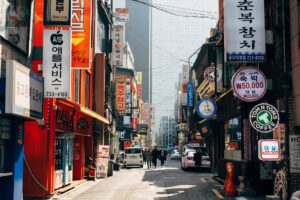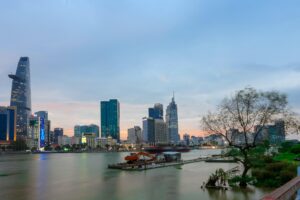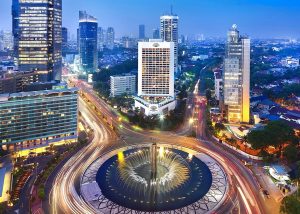Markets

Australians made around 11.6 million international trips in the year ending December 2024, showing a 16.2% increase year-on-year, surpassing pre-pandemic levels. The top destination for Australians continue to be Bali, Indonesia, while Japan, United States and Vietnam seen significant growth as the popular holiday choice.
Small-group and organised tours lead the way for the preferred travel method for Australians. While Australians are known to take long overseas holidays to maximise their long-haul travel, shorter trips (less than 10 days) but in a single destination are showing strong growth as well.
For luxury travel, baby boomers remain key luxury travellers from Australia, opting for business-class flights, luxury river cruises, and premium hotels. This segment is less affected by cost pressures and demand high-end experiences. Immersive single-destination itineraries focused on structured comfort will lead the way in capturing the outbound Australian market.
China’s outbound travel rebounded robustly in 2024, with over 145 million trips, marking a 17% year-on-year rise in travel spending, totalling 5.75 trillion RMB. During the 2024 National Day Golden Week in October, transactions by Alipay users abroad surged 60%, while spending spiked 120%, illustrating strong travel engagement.
Travel behaviours among Chinese travellers saw massive shifts post-covid: more personalised smaller group trips or solo trips, especially among high spenders who stay longer, stay at upscale hotels; increasing senior/silver travel segments; as well as a greater preference for unique experiences over material indulgence.
Another significant segment – travellers in their 30s – value quality, craftsmanship, storytelling, and culturally rich experiences over traditional branding and status. These digital-savvy travellers usually book their travel very spontaneously, usually weeks before departure.
While luxury spending remains essential, amid the current economic uncertainty, Chinese travellers are becoming more sensitive to price tags and the perceived value of the goods or services.

In 2024, Hongkongers made approximately 28.6 million outbound visits, excluding visits to China and Macau. Total international tourism expenditure was US $26.4 billion, according to data provided by VisitBritain.
A visible shift was seen from the outbound Hong Kong market towards independent travel. According to Future Market Insights, online bookings will lead the growth in outbound travel. In addition, premium “Free Independent Travelers” (FITs) are a growing segment, travelling more frequently, with more intention, and more budgets.
While luxury retail sales are declining in Hong Kong, travellers are spending more on shopping abroad or at duty-free stores. Hong Kong travellers are spending more on premium travel products too: Cathay Pacific’s launch of Aria Suites (business class) was highly favoured by travellers looking for privacy, Michelin-star dining, spa-inspired amenities, and seamless check-in services on long-haul routes such as London and Sydney.

2024 marked India’s highest-ever outbound travel figure, fuelled by an expanding middle class and improved global air connectivity. Indian international travel spending hit US $31.7 billion in 2024, a 25% increase over the previous year. This milestone places India among the world’s top outbound spenders.
Millennials and Gen Z constitute almost half of outbound travellers, underscoring a younger and digitally fluent audience. Travel is now driven by leisure, cultural immersion, adventure, honeymoons, and VFR, an evolution from traditional business or pilgrimage. Popular destinations span from classic honeymoon spots like the Maldives and Europe to adventure and remote options like Georgia and Azerbaijan.
On the luxury travel segment, business-class international flight bookings jumped 50% year-on-year, while international flight demand rose 80%, signalling strong premium demand. Indian travellers are also increasing their travel spend overseas, in order to enjoy personalised, immersive journeys over traditional extravagance.
Indonesians made approximately 13.9 million outbound trips in 2024, up from 11.68 million in 2023 and nearing the pre-pandemic level of 16.1 million in 2019. Despite economic pressures, outbound travel is thriving. Indonesians are favoring value-oriented options, prioritizing destinations with good deals, package flexibility, and budget alignment.
While religious travel make up most of the outbound trips, travel interests to Northern Europe increased by 30 to 35% among affluent Indonesians.
While mid-luxury travelers dominate, there’s a noticeable upward trend in more affluent segments venturing farther and paying for convenience and exclusivity. Research from Skift highlights that Indonesian travellers favour private tours and all-inclusive packages. Tour operators are jumping on the trend, offering “super deals” for premium destinations, capturing the value-seeking premium travellers.
The blend of premium interest and value-seeking behavior spurs the Indonesian outbound travel market, encouraging travel brands to design hybrid premium offerings.

Japan’s outbound travel is rebounding gradually, with an estimated 14.5 million Japanese travelling abroad in 2024. This is a 152.6% increase from 2023, but still just about 72% of 2019 numbers. On the contrary, inbound tourism has surged with a record 36.9 million visitors in 2024.
According to a JTB survey, Japanese travellers are looking to visit the United States, Europe, Australia and New Zealand the most. Summer season saw the highest number of outbound departures.
While FIT travel has grown, package travel remains relevant, especially for long-haul destinations. Japanese travellers are emphasising experiential and meaningful journeys, from wellness and slow travel to cultural immersion and luxury train journeys.
Like other parts of Asia, Japanese travellers value “quiet luxury” – understated, private and authentic experiences. High-end train travel as mentioned above are popular options for inbound and outbound travel.

South Korea stands as one of Asia’s largest and most dynamic outbound travel markets. In 2024, approximately 28.7 million South Koreans traveled abroad, marking a near-complete recovery relative to pre-pandemic levels. Outbound tourism spending reached about US $26.49 billion, reflecting a 6% increase over 2023.
Koreans are travelling longer when abroad, with 10+ day international stays rising by 27% year-over-year. A notable rise is reported in luxury expedition travel and exclusive cultural experiences among premium travellers. Other key segments include customised vacations, culinary and shopping journeys.
Koreans are highly driven by public holidays: around 650,000 outbound trips departed during Chuseok, and travel agencies often push packages about one year in advance to capture the family travel segment.
Online bookings and OTA platforms are rapidly growing, especially for FIT travellers. Even traditional agencies are jumping on the digital platforms to attract the younger demographic. Nevertheless, while spontaneous independent travel surged post-pandemic, there's a renewed interest among both younger and senior travellers in premium but competitively priced package tours.

According to VisitBritain’s International Passenger Survey, Malaysians made 11.3 million outbound visits in 2024, with total international tourism expenditure of US $11.6 billion.
The preferred outbound destinations are Thailand, Indonesia, Singapore, Japan, and China. A recent Klook survey found that nearly 3 in 4 Malaysians expressed interest in visiting Japan, South Korea, or China as future destinations. Travelling long-haul is impeded by lack of flight connectivity, and a weak Malaysian Ringgit. That said, the UK is the most visited European destination.
It is worthy to note that domestic tourism in Malaysia has outgrown outbound tourism, with about 260 million domestic visitor trips made in 2024.
Nevertheless, the outbound tourism market of Malaysia remains optimistic, with a planned expansion of the Kuala Lumpur International Airport and an active reactivation of Subang airport. The Malaysian Ringgit is steadily appreciating, increasing travel confidence when spending overseas.

New Zealanders made approximately 3.5 million outbound visits in 2024, with total international tourism expenditure reaching US $4.3 billion. Proximity and cultural familiarity make Australia the leading choice, followed by destinations like the UK, USA, Fiji, and Indonesia.
New Zealanders show growing interest in exclusive luxury escapes, who value aesthetic appeal, sustainability, and wellness. Like in the rest of Asia, New Zealanders seek luxury multi-generational travel and private villa stays, domestically, as well as abroad.
While New Zealanders are not the most frequent outbound travelers in the Asia-Pacific, when they do travel overseas, their average expenditure aligns with premium expectations.

Approximately 6.85 million Filipinos traveled abroad in 2024, encompassing both tourists and Overseas Filipino Workers (OFWs). 60% of the total outbound trips were to Asian destinations.
The Filipino outbound travel market has seen strong rebound, with a 35% increase in outbound ticket sales in 2024, according to Trevolution. While length of stay has reduced, it suggests a shift toward shorter but more frequent trips abroad.
Attractions and events remain a major draw for Filipino travellers when travelling abroad. Proximity, visa-free access and affordability are other major factors influencing travel decisions. Most of all, booking behaviours are largely fueled by social media inspirations.
Finally, the premium segment in the Philippines is growing significantly. Airlines and travel agencies are beginning to cater to upscale preferences, from first-class flight experiences to bespoke vacations.

The Thai Travel Agents Association (TTAA) estimated that around 10 million Thais travelled abroad in 2024, reflecting a modest growth of 5–7% year-on-year. The top destinations for Thai travellers are Japan and China, due to their visa-free policy towards Thai travellers. An estimated 2.5 million bookings were made to these 2 destinations. Other traditional favourites include Malaysia, Vietnam, South Korea and Taiwan.
A Visa study highlights Thai travellers’ high expenditure on department stores, apparel, accessories and restaurants. When travelling abroad, high-end retail and fine dining are key outbound expenditures.
Nevertheless, Thai travellers are moving beyond extravagant purchases. Authentic, emotional, and wellness experiences are gaining popularity. In addition, business trips are evolutionarily becoming pleasure-augmented journeys, reflecting hybrid lifestyles and rising disposable incomes in the luxury tier.

With a small population of almost 6 million, Singaporeans made approximately 10.4 million outbound visits throughout 2024, and provided an approximate US$15 billion of total international tourism expenditure.
While the most popular travel destinations continue to be near home – Malaysia, Indonesia, Thailand, China, and Japan, long-haul markets of the UK, USA and France continue to be popular, especially among the high-spending travellers.
Highly educated and cost-conscious, Singaporean travellers are sensitive to favourable exchange rates and local spending, that often persuade travel decisions.
Singaporeans prioritise shopping and dining during their travel and are increasingly travelling on premium cabins on long-haul travel. Luxury travel growth stood at 37% in 2024, according to Masscomm, a global advertising company. This shows a strong rebound for outbound travel from Singapore, as well as a shift toward high-value long-haul travel.

Vietnam sent approximately 5.3 million travellers abroad in 2024, a humble number compared to other markets in the region but is expected to bring the highest growth potential. Intra-Asia travel dominates due to its flight availabilities, and most trips last less than a week.
Traditional group tours continue but are rapidly declining in demand among outbound Vietnamese travellers, as travellers prioritise flexibility and prefer DIY trips with family or friends. Planning horizons are therefore becoming compressed.
The travel demographic of Vietnam is made up predominantly of Gen X travellers, who have more means to travel than the younger Vietnamese population. With a marked wealth surge among the Vietnamese population, appetite for luxury consumption has likewise increased significantly. They seek more premium and experiential travel, with a focus on high-end culinary offerings.

An estimated 15.5 million overseas trips were made by Taiwanese travellers, with nearly 90% of the trips within Asia. Travel to the United States stood at about 5%, and to Europe at about 3%.
Market insights suggest a growing inclination toward independent travel, especially for short-haul trips. Curated or packaged tours are still sought after particularly for long-haul or experiential journeys like wellness hikes in Europe (like to the Dolomites) or pilgrimage tours. Study tours, or cultural immersion programmes, are likewise growing popularity with students as well as older travellers.
A study focused on Taiwanese luxury travellers found a demographic skew toward middle-aged to older adults, who are motivated to engage in family and multi-generational travel. Luxury travel often capitalises on branded shopping and culinary experiences.


